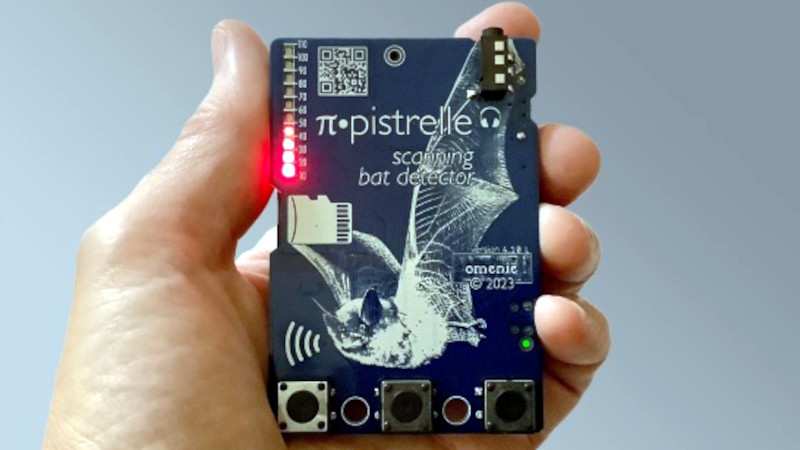The range of human hearing goes up to about 20 kilohertz, which is fine for our purposes, but is pretty poor compared to plenty of other animal species. Dogs famously can hear up to about 60 kHz, and dolphins are known to distinguish sounds up to 100 kHz. But for extremely high frequencies we’ll want to take a step into the world of bats. Some use echolocation to locate each other and their food sources, and bats like the pipistrelle can listen in to sounds up to 350 kHz. To listen to them you’ll need a device like the π*pistrelle.
The original implementation of the bat detector was based on a Raspberry Pi Pico, from which it gets its name. But there have been several improvements on it in the years since it was first developed. The latest can detect bats when it hears their 350 kHz sonar calls thanks to an ultrasonic microphone and op amp. The device then records the bat sounds and then either heterodynes the sound down or time-expands it to human-audible range so the calls can actually be heard. There’s an LED display on the board as well as three input buttons, but an iOS companion app is available to interact with the device as well.
If you want to know for sure which species is flying around at night, you can use machine learning to help figure that out.
















Nice.. I built an analog heterodyne module for listneing to bats a few decades ago . This could be a fun update.
Now hold on a minute there, bats don’t have a deep, dark voice like Batman does? I feel i’ve been misled.
Batman is actually a castrated bat breathing argon, that´s why.
Catwoman is going to be so disappointed!
I think that most MEMS microphones used in phones today have a pretty wide bandwidth if provided raw data, and the hardware might not be necessary at all. And a phone has more processing power for digitally process the sound.
Many of the mic datasheets show the mics as being good up to 10 kHz when in reality they are capable of receiving over 384 KHz.
When I was a young back in the 1960’s I had the opportunity to go hunting for bats with the late scientist and bat expert Donald Griffin. He had this box that looked and gave off clicks like a Geiger counter except of course the detector was an ultrasonic microphone. I was amazed at just how many bats came out and flew around just after sunset. A lot of them were flying around street lamps going after the bugs that hung around there. One of the cool tricks I saw him demonstrate was to throw a tiny bit of and up in the air about 20 feet in front of and about 10 feet or so lower than the direction that the bat was flying. The bat of course would think that the bits of sand were a swarm of bugs and the clicks from the detector would become quite rapid as the bat used it’s echo location skills to track what it thought was a swarm of bugs and at the same time it would change course and dive right into it. https://en.wikipedia.org/wiki/Donald_Griffin
beautiful thing, it will be possible to broadcast information for bats where to look for mosquitoes that annoy us.
Nice, very useful design. Doesn’t look like the creator published a schematic unfortunately. I guess it can be reverse engineered easily enough from the PCBs.
I wonder what’s the minimum device with enough processing power to reproduce the sounds in proportional frequencies at full speed – by which I mean, if you’re in “dog” mode, 60kHz becomes 20kHz and 6kHz becomes 2kHz. Much like the pitch-change mode in Audacity. I think it would be intuitive.
Human hearing goes up to 20kHz for YOUNG humans. I doubt I’ve been able to hear that since my 20s or early 30s. Now in my late 60s, I lose about 40db at 8kHz.
But as a boss of mine once said “It keeps me from wasting money on audiophile-quality stereos”, though I wish my Windows laptop could use some of that spare GPU horsepower doing audio equalization.
(I assume Mac’s can do that, and iPhones should be able to but I’ve never found how.)
What are the odds – blog article mentioning bats, right next to blog article mentioning SARS-Cov2?
I have just published an Android app for configuring the Pipistrelle https://play.google.com/store/apps/details?id=com.zbm2.pipistrelle
Back when I was doing bat surveys as part of an ecology course at university we used “Anabat.” Looks like they’re still around: https://www.titley-scientific.com/au/products/anabat-systems?SID=tmv224g58vpfi5qi1skb9t4qa6